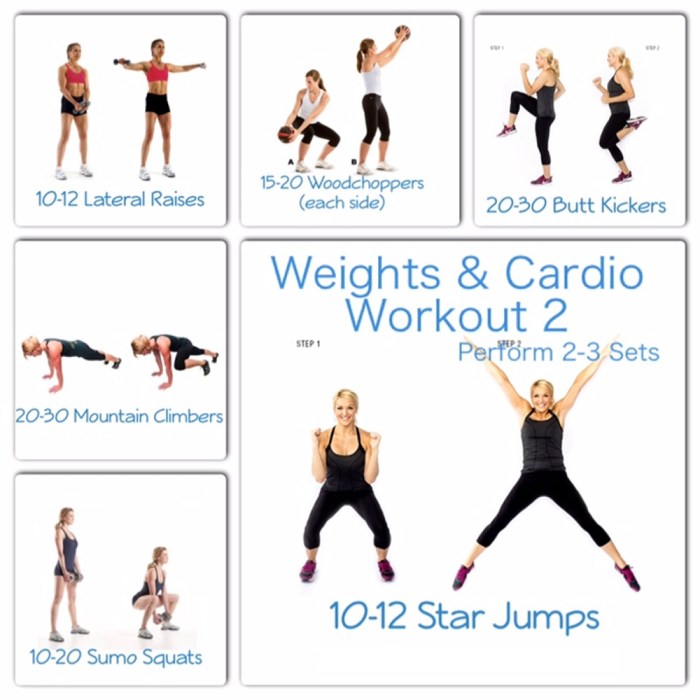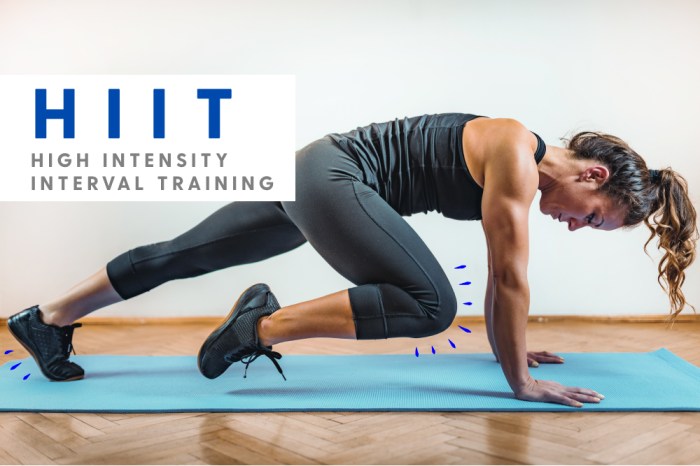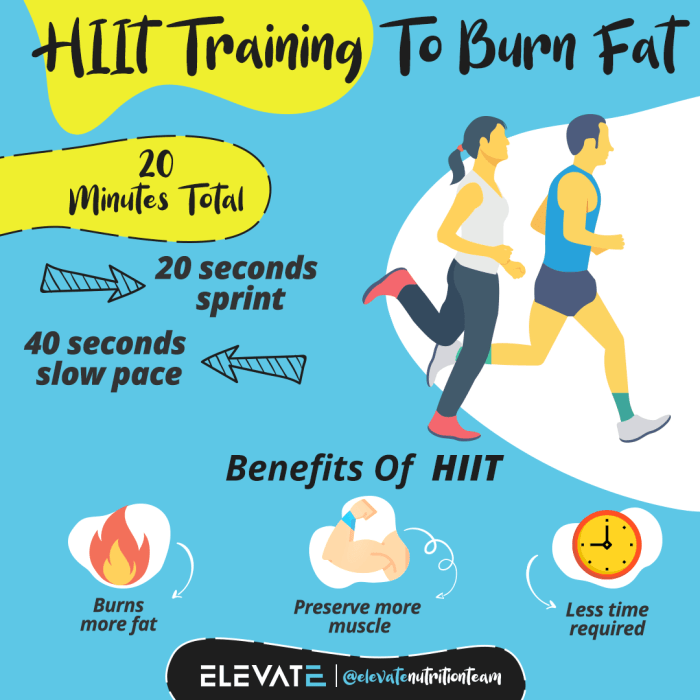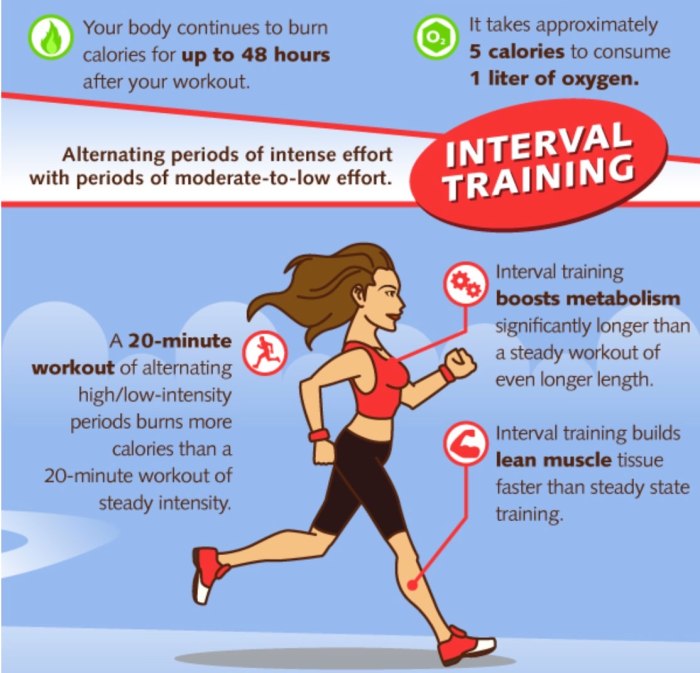High-Intensity Interval Training (HIIT): A Powerful Fitness Approach

High-intensity interval training (HIIT) has taken the fitness world by storm, offering a time-efficient and effective way to improve cardiovascular health, boost metabolism, and build muscle. This workout style involves short bursts of intense exercise followed by brief recovery periods, challenging your body in a way that traditional steady-state cardio simply can’t.
Whether you’re a seasoned athlete or just starting your fitness journey, HIIT can be tailored to your individual needs and goals, making it a versatile and rewarding training method.
The origins of HIIT can be traced back to the 1970s when researchers observed the benefits of short, high-intensity sprints for improving athletic performance. Over time, HIIT evolved into a more comprehensive fitness approach, incorporating a variety of exercises and protocols to maximize its effectiveness.
Today, HIIT is widely recognized as a valuable tool for achieving a range of fitness objectives, from weight loss to enhanced athleticism.
Introduction to HIIT: High-intensity Interval Training (HIIT)

High-intensity interval training (HIIT) is a popular fitness approach that involves short bursts of intense exercise followed by brief recovery periods. This alternating pattern of high-intensity effort and rest is the defining characteristic of HIIT workouts. HIIT workouts are designed to maximize your fitness gains in a relatively short amount of time.
By pushing your body to its limits during high-intensity intervals, you can improve your cardiovascular health, build muscle, and burn calories more efficiently than traditional steady-state cardio.
The Principles of HIIT
The core principle of HIIT is to alternate between periods of high-intensity exercise and periods of rest or low-intensity exercise.
- High-Intensity Intervals: These are periods of intense exercise where you work at a high percentage of your maximum heart rate (typically 80-95%). This could involve sprinting, jumping jacks, burpees, or other exercises that demand a high level of effort.
- Recovery Intervals: These are periods of rest or low-intensity exercise that allow your body to recover from the high-intensity intervals. Recovery intervals can involve walking, jogging, or simply resting.
The duration and intensity of both the high-intensity and recovery intervals can be varied depending on your fitness level and goals. However, a typical HIIT workout might involve 20-30 seconds of high-intensity exercise followed by 10-20 seconds of recovery.
The History of HIIT
The concept of interval training has been around for decades, dating back to the early 20th century. However, the modern form of HIIT, with its emphasis on high-intensity bursts, emerged in the 1990s and gained popularity in the 2000s.
- Early Origins: Early forms of interval training were used by athletes in various sports, such as track and field, to improve their speed and endurance.
- Modern HIIT: The modern form of HIIT was popularized by researchers like Dr. Izumi Tabata, who conducted a study in the 1990s that demonstrated the effectiveness of high-intensity interval training for improving both aerobic and anaerobic fitness.
- Increased Popularity: HIIT has become increasingly popular in recent years, thanks to its time efficiency and effectiveness. It is now widely used by athletes, fitness enthusiasts, and the general population.
Benefits of HIIT
High-intensity interval training (HIIT) is a highly effective workout strategy that alternates between short bursts of intense exercise and brief recovery periods. This method offers a multitude of benefits that extend beyond traditional steady-state cardio.
Cardiovascular Benefits
HIIT has a profound impact on cardiovascular health, leading to improvements in heart health and increased VO2 max. The intense bursts of exercise elevate your heart rate, pushing your cardiovascular system to work harder, leading to increased efficiency and strength.
This translates to a healthier heart, improved blood flow, and a lower risk of heart disease.
HIIT workouts can help increase your maximum oxygen uptake (VO2 max), a measure of your body’s ability to utilize oxygen during exercise. This means you can work harder and longer before feeling fatigued.
Fat Loss and Weight Management
HIIT is renowned for its effectiveness in fat loss and weight management. The intense bursts of exercise elevate your metabolic rate, which remains elevated even after your workout is complete. This “afterburn” effect, known as excess post-exercise oxygen consumption (EPOC), helps you burn more calories throughout the day, promoting fat loss.
Studies have shown that HIIT can be more effective than traditional cardio in burning fat and improving body composition.
Muscle Building and Strength Gains, High-intensity interval training (HIIT)
While HIIT is primarily known for its cardiovascular benefits, it can also contribute to muscle building and strength gains. The intense bursts of exercise stimulate muscle protein synthesis, which is essential for muscle growth.
While HIIT may not be as effective as weight training for building massive muscle mass, it can help increase muscle strength and endurance.
HIIT Workouts

HIIT workouts are structured to alternate between short bursts of intense exercise and brief recovery periods. This approach maximizes calorie burn and improves cardiovascular fitness.
Sample HIIT Workout Routine for Beginners
This routine is designed for beginners and can be adjusted based on individual fitness levels. Warm-up (5 minutes)
- Light cardio, such as jogging in place or jumping jacks (2 minutes)
- Dynamic stretching, including arm circles, leg swings, and torso twists (3 minutes)
Workout (20 minutes)
Round 1
Jumping jacks (30 seconds)
Rest (30 seconds)
High knees (30 seconds)
Rest (30 seconds)
Butt kicks (30 seconds)
Rest (30 seconds)
Push-ups (30 seconds)
- Rest (30 seconds)
- Round 2
Squats (30 seconds)
Rest (30 seconds)
Lunges (30 seconds)
Rest (30 seconds)
Plank (30 seconds)
Rest (30 seconds)
Bicycle crunches (30 seconds)
Rest (30 seconds)
Cool-down (5 minutes)
Static stretching, holding each stretch for 30 seconds (5 minutes)
Examples of HIIT Exercises
Here are examples of HIIT exercises categorized by muscle groups targeted: Lower Body
Cardio
Jumping jacks, burpees, mountain climbers, high knees, butt kicks, squat jumps, lunges.
Strength
Squats, lunges, deadlifts, calf raises Upper Body
Cardio
Push-ups, burpees, mountain climbers, jumping jacks
Strength
Push-ups, pull-ups, bench presses, rows of Core
Cardio
Plank, bicycle crunches, Russian twists, mountain climbers
Strength
Plank, side plank, ab crunches
Adjusting Workout Intensity and Duration
The intensity and duration of HIIT workouts can be adjusted based on fitness level and goals.* Beginners: Start with shorter workouts (15-20 minutes) and fewer repetitions.
Intermediate
Increase the duration and intensity gradually, adding more repetitions or challenging exercises.
Advanced
Aim for longer workouts (30-45 minutes) with higher intensity and more challenging exercises.
It’s important to listen to your body and adjust the workout as needed.
HIIT Variations

HIIT workouts come in various forms, each tailored to different fitness goals and preferences. While the core principle of alternating high-intensity bursts with recovery periods remains constant, these variations offer a diverse range of approaches to maximize your workout’s effectiveness.
Tabata Training
Tabata training is a high-intensity interval training protocol named after its creator, Dr. Izumi Tabata. It involves performing a specific exercise at maximum intensity for 20 seconds, followed by 10 seconds of rest. This cycle is repeated eight times for a total of four minutes.
Tabata training has gained popularity for its time-efficient nature and its ability to deliver significant improvements in cardiovascular fitness, anaerobic capacity, and muscle strength.
Tabata Training Protocol: 20 seconds of intense exercise followed by 10 seconds of rest, repeated eight times for a total of four minutes.
Tabata training is particularly effective for improving:* Cardiovascular Fitness: The high-intensity bursts elevate your heart rate and improve your cardiovascular endurance.
Anaerobic Capacity
This training protocol enhances your body’s ability to produce energy without oxygen, essential for short bursts of intense activity.
Muscle Strength
The high-intensity exercises engage your muscles and promote muscle growth.
Circuit Training
Circuit training involves performing a series of exercises in a circuit, with minimal rest between exercises. Each exercise targets a different muscle group, providing a full-body workout. This variation offers a balanced approach to fitness, improving strength, endurance, and flexibility simultaneously.
Circuit Training Protocol: Perform a series of exercises in a circuit, with minimal rest between exercises, targeting different muscle groups.
Circuit training is ideal for:* Full-Body Workout: It engages multiple muscle groups, providing a comprehensive workout.
Time Efficiency
It saves time by eliminating lengthy rest periods between exercises.
Variety
The variety of exercises keeps your workout engaging and prevents boredom.
Sprint Intervals
Sprint intervals involve alternating between short bursts of sprinting and periods of active recovery, such as jogging or walking. This variation is specifically designed to enhance speed, power, and cardiovascular fitness.
Sprint Interval Protocol: Alternate between short bursts of sprinting and periods of active recovery, such as jogging or walking.
Sprint intervals are highly effective for:* Speed and Power: The intense sprints improve your speed and explosive power.
Cardiovascular Fitness
The high-intensity bursts elevate your heart rate and improve your cardiovascular endurance.
Fat Burning
Sprint intervals are highly effective for burning calories and fat.
Comparison of HIIT Variations
| Variation | Advantages | Disadvantages ||—|—|—|| Tabata Training | Highly time-efficient, improves cardiovascular fitness, anaerobic capacity, and muscle strength | Requires high intensity, may be challenging for beginners || Circuit Training | Full-body workout, time-efficient offers variety | May require more equipment, can be demanding || Sprint Intervals | Improves speed, power, and cardiovascular fitness, effective for fat burning | May be challenging for beginners, requires access to a track or running space |The effectiveness of different HIIT variations depends on your individual fitness goals and preferences.
For example, Tabata training is ideal for those seeking to improve cardiovascular fitness and anaerobic capacity in a short time. Circuit training is a versatile option for a full-body workout, while sprint intervals are best for athletes aiming to enhance speed and power.
HIIT Safety and Considerations

While HIIT offers numerous benefits, it’s crucial to prioritize safety and prevent potential injuries. This section delves into essential considerations for a safe and effective HIIT experience.
Proper Form and Technique
Maintaining proper form during HIIT exercises is essential for injury prevention. Incorrect technique can strain muscles, joints, and ligaments, leading to discomfort and potential injuries.
- Focus on quality over quantity: Prioritize proper form over the number of repetitions or speed.
- Engage core muscles: Actively engage your core muscles throughout each exercise to provide stability and support.
- Control movement: Avoid jerky movements or sudden bursts of force. Control your movements throughout the exercise range.
- Maintain proper posture: Ensure your spine is aligned, shoulders are relaxed, and head is in a neutral position.
- Use proper equipment: If using weights or resistance bands, select appropriate weights and ensure they are secure.
Listening to Your Body
It’s crucial to pay attention to your body’s signals and adjust workouts accordingly. Ignoring pain or pushing yourself beyond your limits can lead to injuries.
- Warm up adequately: A proper warm-up prepares your muscles and joints for the intensity of HIIT, reducing the risk of strains and tears.
- Listen to your body: If you feel pain, stop the exercise immediately and consult a healthcare professional if necessary.
- Take rest days: Allow your body sufficient time to recover between HIIT sessions.
- Progress gradually: Increase the intensity or duration of your workouts gradually, allowing your body to adapt.
Hydration and Recovery Strategies
Hydration and recovery are essential for optimizing HIIT performance and preventing fatigue and injuries.
- Hydrate before, during, and after: Drink plenty of water throughout the day, especially before, during, and after HIIT sessions.
- Proper nutrition: Consume a balanced diet rich in fruits, vegetables, and lean protein to support muscle recovery and energy levels.
- Active recovery: Engage in light activities like walking or stretching on rest days to promote blood flow and aid recovery.
- Sleep: Aim for 7-9 hours of quality sleep each night to allow your body to repair and rebuild muscle tissue.
HIIT for Specific Populations

HIIT can be a valuable tool for individuals with specific health conditions, pregnant women, older adults, and those recovering from injuries or surgeries. However, it is crucial to adapt the program to their unique needs and limitations.
HIIT for Individuals with Diabetes or Obesity
HIIT can be particularly beneficial for individuals with diabetes or obesity. It helps improve insulin sensitivity, reduce blood sugar levels, and enhance weight management.
- Benefits: HIIT can improve insulin sensitivity, leading to better blood sugar control. It also helps in weight loss by burning more calories than traditional cardio.
- Considerations: individuals with diabetes or obesity should consult with their doctor before starting HIIT. They may need to adjust their medication or monitor their blood sugar levels more frequently. It’s important to start with a low-intensity program and gradually increase the intensity and duration.
HIIT for Pregnant Women
This can be a safe and effective form of exercise for pregnant women, but it is important to make modifications.
- Adaptations: Pregnant women should avoid exercises that put pressure on the abdomen, such as sit-ups or planks. They should also choose low-impact exercises, such as walking, swimming, or cycling.
- Considerations: Pregnant women should listen to their bodies and stop if they experience any pain or discomfort. They should also avoid exercising in extreme heat or humidity.
HIIT for Older Adults
This can be beneficial for older adults, but it’s essential to adjust the program to their needs.
- Adaptations: Older adults should start with a shorter duration and lower intensity. They should also focus on exercises that are safe and easy to perform.
- Considerations: Older adults should consult with their doctor before starting HIIT. They may need to modify the exercises or use assistive devices.
HIIT in Rehabilitation Programs
HIIT can be a valuable tool in rehabilitation programs after injuries or surgeries. It can help improve strength, endurance, and balance.
- Role: HIIT can help individuals regain lost function and improve their overall fitness. It can also help prevent future injuries.
- Considerations: Individuals should consult with their physical therapist or doctor before starting HIIT. They may need to start with a low-intensity program and gradually increase the intensity and duration.
Closing Summary

By incorporating HIIT into your fitness routine, you can unlock a world of benefits, from improved cardiovascular health to increased muscle mass. Remember to listen to your body, progress gradually, and consult with a healthcare professional if you have any underlying health conditions.
With proper planning and execution, HIIT can be a transformative experience, empowering you to reach your fitness goals and live a healthier, more fulfilling life.
Comments are closed.